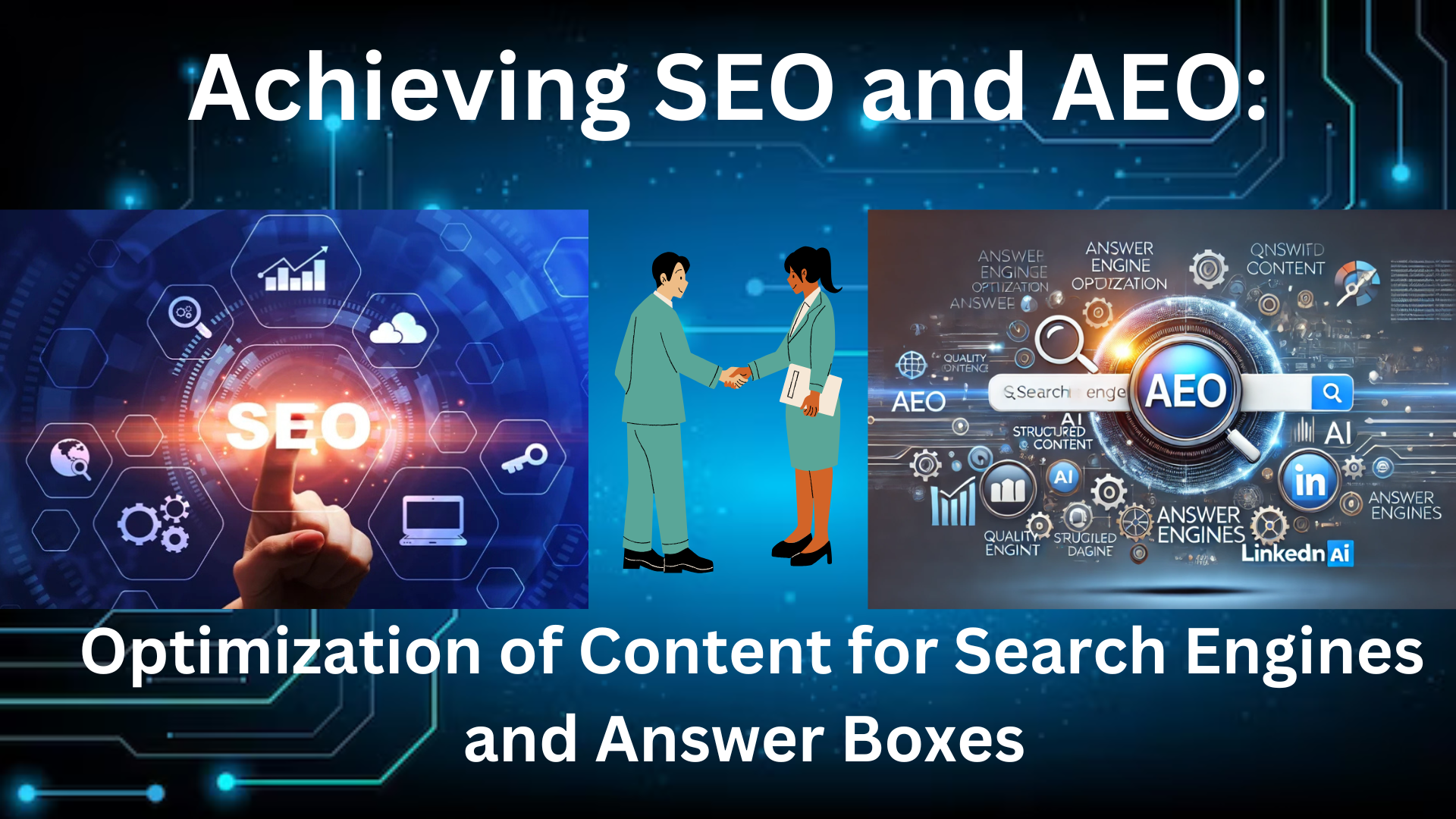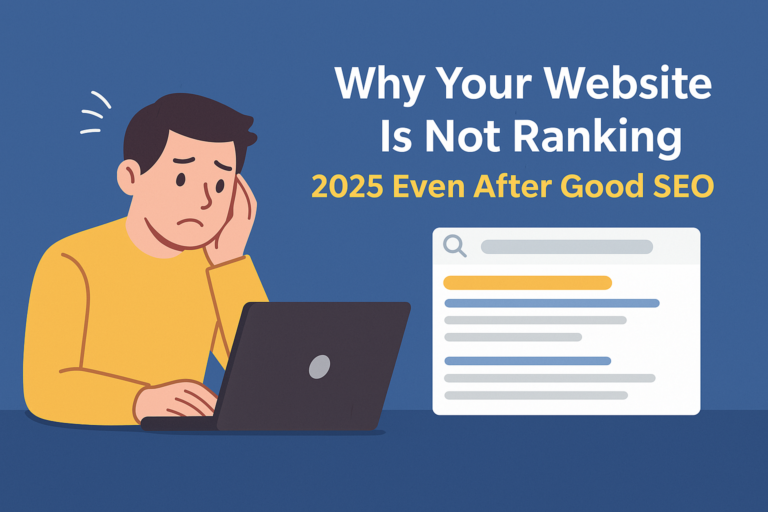Master both SEO and AEO today for better visibility and organic traffic on your content, especially in this digital age. Though SEO is an older science, the rise of voice search, featured snippets, and answer-driven queries ushered in a new baby-what is named AEO. That’s what this guide is going to take you through with the essentials of optimizing your content to rank better not only for SEO but also for AEO so that your website ranks higher in both traditional search results and the answer box.
How to Improve Your Website for SEO and AEO?
Understanding the difference between SEO and AEO, how they work with each other, and then how that will help create improvement on your rankings is crucial for beginners.
What is SEO?
Search engine optimization, abbreviated as SEO, is a technique of enhancing your website and content so that you can rank higher in the search engine result pages. This is achieved by different elements like keyword research, on-page optimization, link building, and technical improvements that make your website search engine friendly. By focusing on natural ranking factors, such as relevance in content, site authority, and mobile responsiveness, SEO targets the display above real users who are seeking information in connection with it.
- Keyword Research: Keyword research is the very base of SEO and is most fundamentally about analyzing search volumes, competition, and user intent behind queries.
- On-Page SEO: On-page optimization refers to optimizing title tags, meta descriptions, headings, alt tags for images, and content in a manner that includes target keywords in a natural way.
- Off-Page SEO: Off-page optimization deals with link-building efforts, such as earning backlinks from authoritative websites signaling trust and relevance.
- Technical SEO: Pertaining to optimizing the website in a way to increase its speed, being mobile-friendly, and its security level via HTTPS, and structure to make it as crawlable as possible to search engines that could easily access and index your content.
What is AEO?
Answer Engine Optimization is a type of optimization that is specifically done to content to rank in the answer boxes and featured snippets, voice search results, as well as other direct answer features in the search results. It aims to increase the likelihood that your content gets selected by the search engine as the best available answer to a user query.
- Featured Snippets: These are the text boxes appearing at the top of search result pages when a query happens to be a question. For AEO, the ultimate goal is to place content into these answer boxes.
- Voice Search: What has been triggering voice searches has really had a good impact in relation to how users search. As if trying to score a point with Google Assistant and Siri, voice searches have become increasingly conversational. AEO focuses on writing content more likely to get read out as answers in voice queries.
- Direct Answer Queries: AEO aims to provide a concise, terse response to a particular user question. Because of this, you’ll have a high possibility that your content will be shown on the search results page as a direct answer.
Interaction of SEO and AEO: How Do They Harmonize?
SEO and AEO are two different concepts with different objectives. However, they complement each other so nicely. Here is the way through which they interact positively to promote your content’s visibility:
Optimizing Keywords
- Whereas SEO focuses on increasing traffic based on broad keywords such as “healthy eating tips, etc. “, AEO focuses on question-based keywords like “What are the healthiest meals that can be prepared?” and long-tail phrases which are oftentimes spoken in voice searches.
- Optimizing both kinds of keywords would broaden your presence in the regular search result and answer boxes.
Content Quality
- Good-quality content is the only requirement for both SEO and AEO. While AEO requires the content to be rich enough and answers most questions of a user.
- For AEO, in short it is clear or concise content that answers a user’s question directly. Sometimes AEO targeting content includes very short answers, very short lists or bullet points or short paragraphs.
- How do you get to that perfect point of depth, brevity and actionability all together in order to make your content rank for both SEO and AEO
Content Structure
- SEO content tends to have a pretty natural structure: headings, subheadings, and obvious sections; for search engines it’s really easy to get a hold of and index that content.
- Format is very important to AEO. This is because search engines need to scavenge for some explicit answers from the contents. Question-formatted sets, especially questions, format in a bullet point or step by step, tend to rank much higher for featured snippets.
- That is because aligned content actually supports SEO and AEO and allows the real possibility of this content being in search results and therefore brings that much closer to appearing on answer boxes or voice search results.
What’s the Difference: SEO and AEO?
While SEO and AEO serve different purposes, they can both be used to enhance user experience. Here’s how they differ:
Focus:
- SEO is focused on large-scale visibility in search queries. It centers around keywords and content topics generally.
- AEO is more focused. It is upon specific questions or direct questions that come from users. Examples include voice search as well as featured snippets.
Type of Content:
- SEO demands more in-depth and more informative content, which entails all topics and is analytical in nature.
- AEO talks about the type of content that is concise and easy to read, where it answers the targeted question on the mind of the user in as few words as possible.
User Intent:
- SEO entails both informational, transactional, and navigational intent.
- AEO aims towards focusing on informational intent where users have a question in their mind and are searching for answers, typically presented in natural language.
Technical Elements
- SEO demands optimization of the technical aspects such as the website speed, mobile usability, and indexing of the content.
- AEO is also a technical optimisation but this time to structure and clarity so that the search engines can understand what your content is extracting from it-the right answer.
Advance SEO and AEO Optimization Techniques
Base and some others thought of more advanced techniques, which could be used to unlock the full potential of both sides.
Voice Search Optimization:
However, the last few years have given birth to voice search using devices such as Google Assistant and Siri, and the content, of course, needs to be optimized to look for results. Voice searches are conversational per se, so efforts have concentrated more on the use of natural language and posing questions directly. In terms of voice search optimization, long-tail, question-based keywords are used, which reflect how people would seek the same information.
Content Clusters and Topic Authority
You build clusters of content around specific topics that enhance the authority of your site. Once it presents a group of relevant content under a pillar page, search engines will then be able to understand your site as one of the most reliable sources about that subject. Such structure endows both SEO and AEO. That is, supports broad keyword rankings, and provides a logical, well-organized answer to associated queries.
Local SEO integrated with AEO
If your business has a physical location, such as a store or location-based services, then optimize it for local search queries and you’ll find that not only will your business appear in search results, but also answer boxes on Google. AEO improves the local SEO answer to questions of location, such as “Where is the nearest pizza restaurant?” Make sure that your content has location terms and will be optimized for local voice searches.
10 Quick Tips to Enhance Both SEO and AEO in Every Blog Post
The following is 10 actionable tips which you can apply immediately to optimize your content on both SEO and AEO:
- Use Natural Language: Optimize for voice search (AEO) as well as keyword-based queries (SEO) by writing in a conversational tone that will make your content soar with voice searches and answer boxes.
- Incorporate Long-Tail Keywords: Long-tail keywords increase your discoverability with voice search and increase the chances of your content ranking for specific questions.
- Write for Featured Snippets: Structure your copy to include simple, straightforward answers to very well-researched questions. You can feature your answers in a bullet point or numbered list. Featured Snippets are picked up more by the engines.
- Optimize Meta Descriptions: Make sure that your meta descriptions are descriptive, and they do contain keywords. For AEO, you immediately answer a user’s question in the description to increase a deeper appearance in answer boxes.
- Improve Load Times: Page speed is the ranking factor for both SEO and AEO. A fast load time improves the customer experience, and it lowers bounce rates. Your engagement in a website will also increase.
- Use Structured Data: This allows you to include schema markup on your content as well as make search engines understand and extract it easily for answer boxes.
- Update Content Periodically: Fresh and updated content shows relevance to Google. Update your blog posts periodically so that they are not left behind current trends and interests of users.
- Create FAQs Sections: FAQs directly answer common user queries. Adding them to your posts increases the opportunity to rank in answer boxes.
- Optimize for Mobile: Your website should be responsive. Google uses mobile-first indexing, so optimizing your website to be mobile-friendly will support both SEO and user experience.
- Use engaging visuals: This encompasses images, infographics, and videos. These make the users on your page stick around for longer durations of time. This enhances positive SEO and increases the likelihood that your content is going to be considered for answer boxes.
Analysis and Measurement of Performance for SEO vs. AEO
After conducting the optimization strategies, it is equally important to continue monitoring and measuring performance. This way, you will be able to fine-tune your efforts to become better constantly.
Key Metrics to Track:
- Organic Traffic: Track growth in organic traffic for an assessment of whether your SEO work is well-planned and works.
- Visibility in Featured Snippet: Use tools like SEMrush or Ahrefs to track if your content is appearing in featured snippets or answer boxes. This helps measure your AEO success.
- Bounce Rate: A high bounce rate may indicate the users are not finding what they’re looking for. Content reduction of bounce rates will help in serving both SEO and AEO ends.
- Click-through rate (CTR): You could measure CTR to verify if the meta titles and descriptions match the intent of the user. In case your CTR is low, it may mean that your snippets are not appealing enough and must be optimized.
Current Trends of SEO and AEO
The world of the internet continues to change day by day. Keeping up with current trends would definitely ensure an edge over competitors.
- AI in Search: Since AI has started to dominate the search, optimizing the content keeping in mind the necessities of algorithms like Google’s BERT or RankBrain will be important. It must sound natural and conversational, optimized for humans as well as for algorithms.
- E-A-T: Expertise, Authoritativeness, Trustworthiness-Part of this is that Google is paying attention to E-A-T; therefore, content has to be authoritative and trustworthy. High-quality content showing expertise on a subject will rank better in both SEO and AEO.
- The Role of Evolved Video Content: Video snippet searches are becoming more prominent in search results. With transcripts, captions, and structured metadata, video content will become more optimized with better visibility in the search results.
- Core Web Vitals: Google’s new focus on Core Web Vitals ensures that website performance—speed, interactivity, and visual stability—continues to play a high role in rankings from both the SEO and AEO perspectives.
Role of Social Media in SEO and AEO
Social media, therefore, impacts SEO indirectly by promoting content visibility and engaging users. On the other hand, social signals are not a direct ranking factor for Google. However, they contribute to higher rankings through increased traffic, shares, and backlinks.
How Social Media Supports SEO?
- Increased Visibility: Sharing content across social sites improves traffic flows on your site. In return, some backlinks towards your website mean that improved rankings will be realized.
- Increased Interactions: Interacting with your audience on social media helps to create relationships, which can indirectly help improve the SEO performance of your content.
How Social Media Improves AEO?
- Q&A Styles: Social media is an informal Q&A hub. By answering the frequently asked questions on Twitter, Facebook, and other platforms, you maximize your chances of having your content shown up in the feature snippet or voice search.
- Content Sharing: The more your content is shared, the higher the chances of search engines noticing it as valuable, thus building chances for improvement in both SEO and AEO.
Social Media Tactics
- Share all your blog articles on multiple social media sites.
- Engage the audience by answering questions and commentaries from followers.
- Use the social networking tool to promote Q&A content that directly answers user queries.
Case Studies or Real-Life Examples
Examples in real life bring highly effective ways through which businesses make use of both SEO and AEO in order to get some really interesting results. These case studies reflect different approaches toward tangible benefits realized in optimizing for both SEO and AEO .
Case Study 1: Health & Fitness Blog
A health and fitness blog catering to weight loss, healthy eating, and hints toward exercising builds both organic traffic and visibility through voice search. Both techniques of SEO and AEO are concentrated together on the blog toward measurable improvements.
SEO Strategy
- They published long-form content, such as “10 Healthy Snacks for Weight Loss” and “The Best Exercises for a Flat Belly.” They also researched long-tail keywords, such as “healthy snacks for weight loss” and “quick workouts for beginners,” which brought highly impressive searches with relatively less competition.
- There were also internal links within the content of other relevant articles, like “How to Keep Healthy Eating Habits” and “Best Weight Loss Supplements,” which made the structure of the site better and easier navigation from one relevant topic to another.
- Backlinks- Received due to guest posting on the high ranking sites within the niche of fitness, and other times from collaborating with other bloggers, thus further developing the authority and positions of the site in search engines.
AEO Strategy
- They also ensured their content was AEO optimized, including many of the easily understandable answers of some of the frequent questions of theirs within their blog and FAQ.
- For example, in the article “Healthy Snacks for Weight Loss,” they had a subhead that was “What Are Healthy Snacks?” and it was basically just a bulleted list of quick snack ideas, which included fruits, nuts, and protein bars. They are going to become instantly recognizable to the search engines so that the snippet can appear as featured.
- Here’s the FAQ part optimized with questions such as “what is a healthy snack to lose weight?” and “how to lose weight with snacks?”-all in easy extraction by voice assistants and answer boxes.
Effect
- Organic traffic to the blog increased by 30% in three months. This is because such an improvement in rankings for targeted keywords and promotion of blog content in featured snippets and answer boxes lead to this effect.
- Their FAQ section began to appear in voice search on Google Assistant, which gave a very straightforward answer to what the users were asking for, including something like “What is a healthy snack for weight loss?” It led to much more traffic and engagement with even more direct intent from the fact that this content now showed up in voice search.
- All that was built by a combination of working on SEO-by-detailed content and backlinks-working on AEO-through structured answers and FAQs, really did build a solid content strategy that was playing nice with multiple search platforms.
Case Study 2: E-commerce Skincare Website
The website is an e-commerce site, focusing on the sales of natural and organic skincare. This scenario, in this case, aimed at improving the site’s discovery by having better search engine results that give the users correct answers. The company wanted its products to come up easily with a direct answer in the common questions people ask about skincare in the results.
SEO Strategy
- It had optimized all the product pages with rich description and had implemented every SEO best practice targeting the transactional informational keyword “buy organic skincare” and “benefits of hyaluronic acid”.
- Every product page had optimized meta descriptions, title tags, and image alt text filled with keywords such as “best natural face serum” or “hydrating skincare cream for dry skin,” which served to rank for extremely high relevant terms.
- It was backed by well-crafted posts like “How to Choose the Best Moisturizer for Your Skin Type” and “Top 5 Ingredients to Look for in Anti-Aging Creams,” as keyword-optimized articles that lead to product pages to convert easily.
AEO Strategy:
- This skincare brand implemented AEO in creating a comprehensive FAQ page answering common questions of concern.
- Questions like “What is hyaluronic acid?” and “why does Vitamin C affect the skin?-questions that one had to meet head-on, summarized in refreshingly simple sentences made interactive by links to product pages with those ingredients in them.
- Schema markup, or structured data, was applied to each FAQ page so that Google can pull out answers. Hopefully, Google will surface these answers in the featured snippet. The page was a good and clear concise “how to” guide on skincare routines, so easy for Google to pick snippets of helpful advice.
Effect
- Improvement in keyword ranking will increase organic search traffic and conversion through product pages on the e-commerce site.
- It will bring a boiling-up general knowledge of their FAQ answers in voice search for related questions of skincare ingredients and routines. Thus, it would make it more easily available for the potential customers to gain more direct and quicker answers and enhance their trust with heightened engagement.
- Schema markup on products and articles had a huge impact in terms of the view and visibility of product pages in rich snippets.
This research correctly demonstrates how an ecommerce site will design productive AEO and SEO strategies so that ranking, user experience, and conversion is managed effectively.
Future of SEO and AEO
With every advancement in technology, so will be with SEO and AEO practices.
- AI and Machine Learning: The AI-driven search algorithms like BERT from Google and RankBrain make contextual over user intent. The future contents will have to be more conversational and context-driven.
- Voice Search: With voice assistants on the rise, voice optimization will become all the more important. Content should be structured in a way that it can answer spoken questions in an explicit and clear manner.
- Core Web Vitals: Page speed, interactivity, and visual stability are more focused on by Google, and the dynamics of these issues will continue to have an effect on rankings; fast, mobile-friendly websites have a competitive advantage.
- Evolving Content Formats: Video, podcasts, and interactive content will contribute more to SEO and AEO. Structured data and clear captions will optimize these formats and make it easier to get ahead on the visibility of search results.
- E-A-T (Expertise, Authoritativeness, Trustworthiness): The content will have to give off an impression of authority and trustworthiness in such a manner that it is ranked highly in terms of SEO and AEO. As such, the content has to be valuable and of higher quality.
With these trends, businesses will ensure their SEO and AEO strategies remain competitive and effective.
Ready to Dominate Search Results and Featured Snippets?
Unlock the full potential of your content by mastering SEO and AEO today! Boost your website’s visibility, drive organic traffic, and secure your spot in voice search and answer boxes.
Contact me to get started.
What is the difference between SEO and AEO?
SEO focuses on optimizing content for visibility on search engine result pages using techniques like keyword research and link building. AEO targets ranking in answer boxes, voice search results, and direct query responses by structuring concise, question-based content.
How do I optimize my website for voice search?
To optimize for voice search, focus on natural, conversational language and long-tail keywords. Include concise answers to commonly asked questions and use schema markup to help search engines understand your content better.
What are featured snippets, and why are they important?
Featured snippets are text boxes that appear at the top of search results, offering concise answers to user queries. They are critical for gaining visibility and ranking in answer-based searches, especially in AEO strategies.
What role does schema markup play in SEO and AEO?
Schema markup provides structured data that helps search engines understand your content. It increases the likelihood of appearing in rich snippets, featured snippets, and voice search results.
How can I combine SEO and AEO for better results?
Focus on content quality, structure, and keyword optimization. Use broad keywords for SEO and question-based, long-tail keywords for AEO. Include clear answers to FAQs and optimize for both search engine crawlers and user experience.
Why is content clustering important for SEO and AEO?
Content clustering builds topic authority by grouping related content around a central pillar page. It supports SEO by boosting keyword rankings and helps AEO by presenting well-organized answers to user queries, enhancing visibility in featured snippets and voice search results.
If you're looking for any services regarding Digital Marketing or Website Developement, Please Contact now.






Leave a Comment